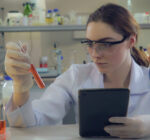First, My Story
I have been ridiculously healthy most of my life, but about a year ago I had two strange episodes during which I was literally unable to talk, for about 15 minutes at a time. Our family physician – God bless him – referred me to a neurologist, who after many scans and other tests, found nothing amiss neurologically. Those two bouts of speechlessness remain a mystery to this day. However, the neurologist suggested that I should see a cardiologist, because one of his tests had picked up something unusual going on with my heart. Shortly before receiving his suggestion, I had started to experience quite severe fatigue and shortness of breath, and my hands and feet began feeling numb. So off I went to see a cardiologist, who scheduled me for more tests. The good news, the cardiologist told me when he received the test results, was that he could make a definitive diagnosis. The bad news: I had an unusual heart condition, which could eventually kill me if left untreated, called Cardiac Amyloidosis.
For people like myself who suffer from this condition, the liver produces proteins that harden the walls of the heart until it eventually stops pumping blood. Until only three years ago, patients with this condition almost always died from it … unless they had a heart transplant, or died from another cause.
But then came more good news. A new drug was recently developed for the treatment of Cardiac Amyloidosis that arrests the damage to the heart being created by the liver – an amazing medical breakthrough. My wife and I were understandably thrilled and extremely thankful. Since the condition was caught early in my case, and because the damage to my heart will not progress any further thanks to this new medication, my lifespan should not be affected by it.
The experience made me think about all the people in the world who have faced a similar situation with a life-threatening health condition. And how many have also hoped and prayed for a medical breakthrough that could save – or at least extend – their lives? This led me to wonder what actual breakthroughs have occurred recently in the world of medicine.
Recent Research and New Treatments: A Few Examples
In October 2022, the U.S. National Library of Medicine lists 430,425 registered medical studies happening in 221 countries worldwide. That includes everything from theoretical experiments, to research in labs, to testing on laboratory mice, to large trials with thousands of patients, which funders hope will lead to newfound knowledge, transformations in paradigms, and more effective types of treatment. Driven by pharmaceutical companies leveraging their patents and saving billions of dollars in risky new types of drug research, scientists have also been repurposing old drugs for surprising results, such as the use of Aspirin to reduce heart attacks.
Long-forgotten approaches and unfamiliar medical procedures have also made their way into mainstream Western medical practice in some cases. For example, “phage” treatment fell out of favour almost 100 years ago, after the use of antibiotics became widespread. Phages are viruses that solely kill and selectively target bacteria. They are the most common biological entities in nature, according to the Center for Innovative Phage Applications in the University of California San Diego’s School of Medicine. And in a number of cases, when antibiotics fail, phages have been shown to succeed in killing the bacteria and saving lives. A recent book entitled The Perfect Predator by Dr. Steffanie Strathdee (Hachette Books, 2019) tells the story of a stubborn epidemiologist from California who saved her husband’s life. While they were vacationing in Egypt, her husband came down with what seemed like a case of food poisoning, but it turned out he was fighting a bacterial infection that the most powerful antibiotic couldn’t address. His life was saved thanks to phage treatment.
We have all heard about nanotech, the use of tiny technology for industry. Did you know that by ‘going small’ we are on the verge of a similar revolution in medicine? Nanomedicine is the application of nanotechnology to achieve innovation in healthcare. By zeroing in on specific areas of the body, these tiny tools can improve our ability to target specific cells or tissues. Nanomedicine ranges from the medical applications of nanomaterials and biological devices, to nanoelectronic biosensors. Produced on a microscopic scale, they are safe to introduce into the body to target conditions like cancer, cardiovascular and neurological disorders, HIV/AIDS, and diabetes. This approach could eventually impact all fields of medicine, with personalized, targeted and regenerative medicine. One great example of research in this area is from the American Cancer Society. Ovarian cancer is very hard to detect, but if caught early is much easier to treat. The Kettering Cancer Centre in New York found that carbon nanotubes – tiny fluorescent particles – can respond to proteins in the blood and give out signals. Researchers there are using machine learning algorithms to make sense of the signals, and found that the nanosensors detect ovarian cancer much better than conventional markers. They are hopeful that this technology can be adapted to provide early detection of many other cancers.
Then there are revelations that parts of our bodies are interconnected in far more ways than previously thought. We used to think that our brain controls much of our nervous system but that nothing could cross the blood-brain barrier. That notion gave us the comfortable feeling that we are protected from nasty things entering our brains. Well, it turns out that not only are there channels for things to enter our brain through the blood and the nervous system, but that they do it continuously. And that connection goes both ways. Our gastrointestinal tract has twice as many neurons as the brain, and the enteric nervous system in our bellies goes far beyond just processing the food we eat. Not only does our brain affect the way our guts operate, but in fact, our guts often control the brain and many other facets of our being. The often-overlooked system of neurons coating our gastrointestinal tract is so pervasive some medical researchers are calling it our “second brain.”
In fact, there are many things about our bodies that we are discovering do not operate the way we previously thought they did. Our bodies contain a vast number of microorganisms including bacteria, viruses, protein, and who knows what else. They outnumber our own cells 10 to 1, hitchhiking and affecting all of our cells from head to toe. 10% Human: How Your Body’s Microbes Hold the Key to Health and Happiness by Dr. Alanna Collen (Harper Publishers, 2016) explains that until the middle of the last century, everyone was taught in school that these other microorganisms in our bodies hardly counted. Recent research tells us quite a different tale. In fact, these little critters not only tag along with our cells, they direct a vast number of processes without which we could not survive (and when we wipe them out with antibiotics or chemo, we open our cells up to all types of attacks.) There is also preliminary research evidence for gut bacteria to have beneficial effects on mood and anxiety, partly by affecting the activity of the vagus nerve (more on vagus nerve stimulation later.)
Medical practices are also changing in developing countries, especially around the equator and among countries in the South. There, malaria is a terrible and pervasive disease — causing fever, tiredness and headaches, and in some cases jaundice, seizures, coma, or death. According to the World Health Organization (WHO), nearly half the world’s population living in 87 countries are at risk of malaria transmission. In 2020, it affected over 200 million people, and caused over 600,000 deaths, 95% of which were in Africa. If not properly treated, people may have recurrences of the disease months and sometimes years later.
 Those of us living in northern climes are rarely affected by malaria so you may not have noticed that there is now a vaccine to prevent it. For those in the global South, this is terrific news. Last year, the WHO endorsed the first large-scale use of a malaria vaccine for children living in areas at risk of transmission.
Those of us living in northern climes are rarely affected by malaria so you may not have noticed that there is now a vaccine to prevent it. For those in the global South, this is terrific news. Last year, the WHO endorsed the first large-scale use of a malaria vaccine for children living in areas at risk of transmission.
For thousands of years, sickle cell disease (SCD) has also caused untold pain and suffering. It is particularly common among those whose ancestors came from sub-Saharan Africa; Spanish-speaking regions in the Western Hemisphere (South America, the Caribbean, and Central America); Saudi Arabia; India; and Mediterranean countries such as Turkey, Greece, and Italy.
This heritable illness causes red blood cells to be crescent-shaped — like a sickle – rather than round. It can choke off blood flow, depriving the body of oxygen. Until recently, blood transfusions and bone marrow transplants were the only courses of action. Today, gene-editing techniques may provide a harmless and effective strategy. A 2021 research effort by scientists and researchers at the Boston Children’s Hospital harnessed a virus to switch off the gene that contorts the cells. Patients produced healthy red blood cells. Almost all participants in the study were able to discontinue the blood transfusions they required until that time.
Then there’s the growing work in stem cells. This approach involves the application of our own cells – the body’s raw materials — to create fresh new blood cells, brain cells, heart muscle cells or bone cells. Though we often think this is restricted to the use of cells from embryos, they can also be collected from umbilical cords, breast milk, and bone marrow. There are a vast number of applications to generate healthy cells that could replace cells affected by disease, including regenerating cells in our blood stream, hearts, spine and even the brain.
In 2021, the WHO reported that cardiovascular diseases are the leading cause of death globally. Besides the usual treatment of heart failure with surgery and medications, many medical professionals now put more focus on addressing behavioural risk factors such as tobacco use, unhealthy diet and obesity, physical inactivity, and harmful use of alcohol. There is also a new non-invasive treatment of blockages known as Intravascular Lithotripsy, or IVL. This uses sonic pressure waves to safely break apart problematic calcium deposits in the arteries. Another fairly new procedure called Transcatheter Aortic Valve Replacement (TAVR) has the potential to change the landscape of heart surgery. It is a minimally invasive heart procedure to replace a thickened aortic valve that can’t fully open, restoring blood flow and reducing symptoms such as chest pain, shortness of breath, and fatigue.
Depression and other mental health conditions are another all-too frequent problem. From depression to anxiety to PTSD, we can’t seem to get away from the psychological vagaries of day-to-day existence. I have struggled with low levels of depression all of my adult life. Fortunately, anti-depressants have lifted my spirits, almost as much as prayer. I also believe that searching for personalized ways of increasing our own sense of wellness is an important key. For me, focusing on the good, opening up to people I trust, being thankful for what I have, meditating, and taking long walks in nature have helped me handle the darkness much of the time. But some people might benefit from other innovative strategies to improve their mental health. Here are two interesting medical practices which have recently been in the news:
- Microdosing of psychedelic medications: Remember how popular – and dangerous – psychedelic drugs were considered to be in the ‘60’s? When someone tells you that they believe in the use of “psychedelics,” you probably think they want to turn the clock back to the hippy era. But backed by recent research, some government jurisdictions are opening up the use of psychedelic drugs for medical purposes using the practice of “microdosing”, which is a very low, sub-hallucinogenic dose of a psychedelic. Microdosing of LSD (lysergic acid diethylamide), magic mushrooms (containing the psychedelic psilocybin), or ayahuasca (a South American psychedelic used socially and ceremonially among the Indigenous peoples of the Amazon basin) are becoming accepted forms of treatment for depression, PTSD and anxiety.
- Vagus nerve stimulation: It seems logical that when we need to reduce stress, we should stop excessive stimulation. But research supports the use of techniques and technology to stimulate the vagus nerve for a calming mental effect, and also to treat epilepsy. Sounds counter-intuitive at first, doesn’t it? However, in our bodies we have two sets of nervous systems. The sympathetic system can be compared to the gas pedal in a car which stimulates us to fight/flee/freeze. In counterbalance, the parasympathetic system helps us put on the brakes. The vagus nerve represents the main component of the parasympathetic nervous system, which oversees a vast array of crucial bodily functions, including control of mood, immune response, digestion, and heart rate. We have a vagus nerve on each side of our body, running from your brainstem through your neck to your chest and abdomen. (The right vagus nerve isn’t used because it is more likely to carry fibers that supply nerves to the heart.) In the past, vagus nerve stimulation involved the use of a device that was surgically implanted under the skin on your chest, with a wire threaded under your skin connecting the device to the left vagus nerve. This would send electrical signals to your brainstem, which then sent signals to certain areas in your brain. New, non-invasive vagus nerve stimulation devices, which don’t require surgical implantation, have been approved in to treat epilepsy, depression, PTSD and pain. As well, a non-invasive device that stimulates the vagus nerve was recently approved in the United States for treatment of cluster headaches.
Conclusion
 Too often, I believe, we take the medical miracles all around us for granted. As the above examples testify, hardworking scientists, physicians, researchers and lab technicians have opened up entire new fields of study, treatment, and ways of thinking about our bodies. We are seeing better pathways to good health, combining old and new discoveries. Hopefully, in time, more and more people around the world will bear the good fruit of these advances.
Too often, I believe, we take the medical miracles all around us for granted. As the above examples testify, hardworking scientists, physicians, researchers and lab technicians have opened up entire new fields of study, treatment, and ways of thinking about our bodies. We are seeing better pathways to good health, combining old and new discoveries. Hopefully, in time, more and more people around the world will bear the good fruit of these advances.
All images from Motion Elements.








